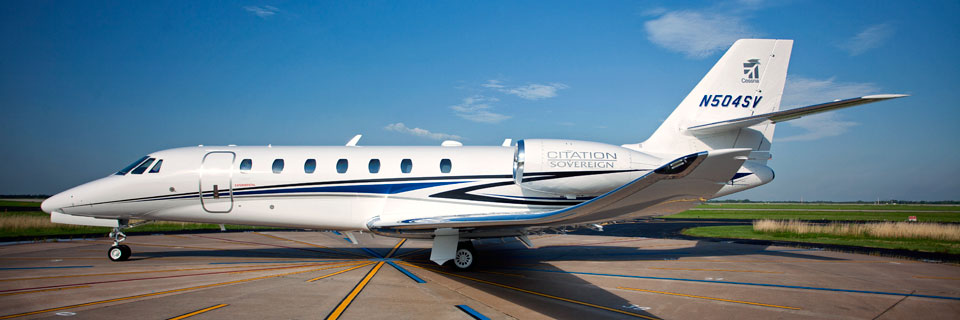
Owner/pilots who’ve reached the top of the single-pilot (SP) jet food chain—most likely in the form of a Cessna Citation CJ4 or Embraer Phenom 300—sometimes wonder, what’s next? For those fortunate enough to be able to make the leap to a bigger jet, the field is wide open, with half a dozen manufacturers making mid-size jets. By updating systems and the airframe, and overhauling the avionics entirely, Cessna is aggressively positioned to capture some of these pilots with the new Sovereign.
Even before the improvements, the Sovereign has attracted owner/pilots stepping up out of SP jets. The heaviest SP jets in wide production feature a max range of about 2,000 nautical miles in still air. While 2,000 miles is a good bit of range, it does not allow a coast-to-coast trip without a decent tailwind, and makes some desirable destinations require out-of-the-way fuel stops (Europe) or impossible to reach at all (Hawaii).
Stepping up to the Sovereign’s 3,000-mile range allows flight from the East Coast to West Coast against nearly any headwind, or New York to London with a light push. One of the Sovereign’s strengths has always been the ability to stretch leg lengths considerably over lighter jets, while preserving excellent short-field performance. Loaded with full fuel and six passengers, the Sovereign still can depart from a sea-level runway as short as 3,650 feet on a standard day.
The most noticeable changes to the new Sovereign are found on the wings and in the cockpit; the former features an extra nine feet of span and graceful “swooplets,” while the latter showcases the pinnacle of Garmin flight decks, the G5000. However, many less immediately apparent improvements lie under the skin, from improvements to the air system’s cooling ability to slight canting of the engine nozzles that lowers VMC and knocks up to 500 feet off wet-runway takeoff requirements.
The first-for-Cessna autothrottles (A/T) represent perhaps the largest avionics and automation improvement to the Sovereign. Engage and Disengage buttons are conveniently located on the throttles, while a knob on the autopilot control panel determines whether the A/T simply holds a speed the pilot dials into the PFD, or follows a sophisticated automatic schedule generated by the FMS—still adjustable as needed. Even with the A/T system disengaged, it is standing by to assist the pilot with automatic under- and overspeed protection. Slowing the aircraft to near stall speed with the AP and A/T disengaged results in the A/T engaging and adding full power at approximately 10 knots over stall speed, providing valuable prestall protection.
Taking in the vast number of switches and knobs on the central pedestal, it’s clear that this is an airplane with a lot more going on in its systems than a light jet. That said, as is true in most modern airplanes, the majority of the switches will only be used in the event of a system malfunction; very little button pushing actually is required during a normal flight. Keeping with modern turbojet design, as many systems as can be automated, have been—navigation lights and beacon lights activate automatically, the APU runs a self-test without prompting as soon as it’s switched on. The flat system pushbuttons can also double as configuration lights, with blue text when in the normal position, white when not. If “everything’s in blue,” all is good.
Much of the increased system complexity comes from the added robustness that Part 25 Transport certification imposes over Part 23 Normal or Commuter certification. For example, unlike light jets that at best may have only fire detection in the baggage compartment, the Sovereign features two baggage extinguishers—one to put out a fire, the second to provide for 180 minutes of slow extinguishing agent release, preventing smoldering material from reigniting. Such advanced features mean very long overwater legs are not only possible because of the extended range, but can be flown with a sense of security not provided by a Part 23 jet.
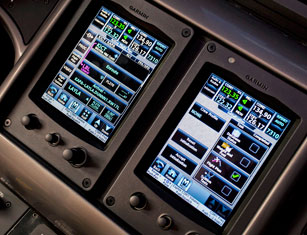
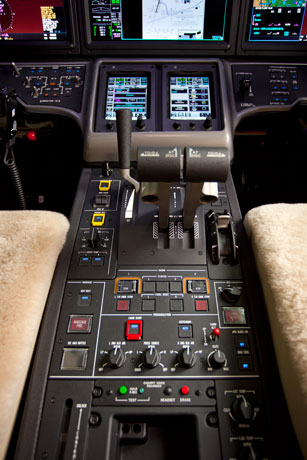
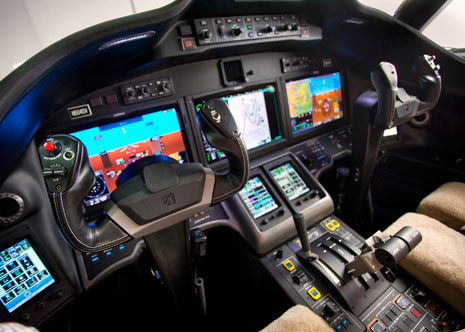
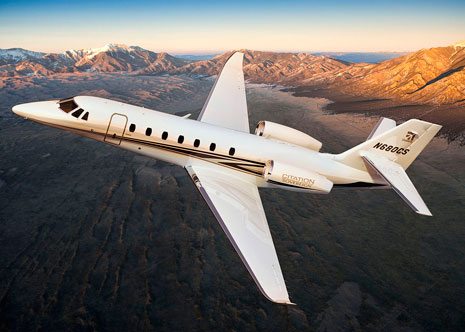
Jammed flight controls? An event that, while unlikely, could be terrifying in a Part 23 jet, is just another abnormal procedure in the Sovereign. Pull the pitch/roll disconnect handle and the left and right half of the elevator are now isolated to the left and right yoke. One pilot also now has all aileron control, while the other has only roll spoiler control; wherever the jam in the system occurred, one pilot will now be left with roll and pitch authority.
The APU undoubtedly will be a system upgrade most appreciated by light-jet pilots who have flown into smaller airports without any GPU, or with a barely functional GPU that drops off line during engine start. Even where GPUs are available, a running APU simply makes the pilot’s life easier—all avionics can be set up for departure when desired, without waiting for a GPU to be towed to the aircraft, a process that can take forever at busy push times.
The G5000 on the whole feels very much like an evolution from the G1000, not an entirely new product. For pilots with Garmin experience, the transition mostly will be forming new habits—where the hand reaches to accomplish which given task. Some tasks required no thought, such as tuning radio frequencies or changing the transponder code; simply touch the field that needs to change and a numeric keypad pops up. Some of the more complex tasks, however—such as editing flight plans or changing map settings—will require some new habit formation.
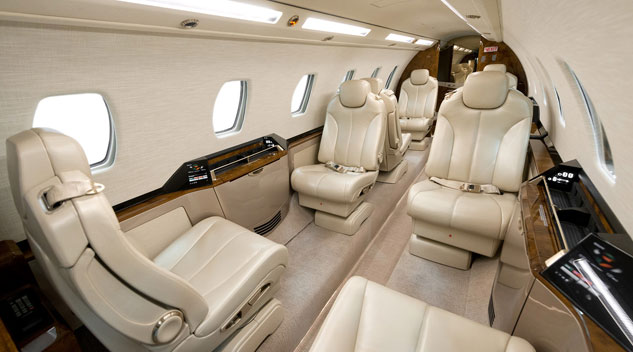
With four touch controllers, each of which can be used for a specific set of tasks, the already shallow menu structure of the G5000 becomes even more pilot friendly. The outboard touch controllers are used primarily to manage PFD functions; the middle two controllers share MFD management, as well as some limited PFD duty when the PFD is displaying extra information such as an approach chart or moving map. It’s a very logical division of responsibility, and soon the pilot will know intuitively which controller accesses a desired function or necessary menu.
The ability to put a screen in the “60/40” split display mode is especially nice. If used on each of the three 14-inch screens, the pilots functionally would have six screens, four of which (the two MFD panels, as well as 40 percent of each PFD) can be configured as desired. An approach plate on one PFD, moving map on the other; radar and XM weather side by side on the MFD? No problem, the combinations are limited only by the pilot’s imagination. Such flexibility added to the PFD’s high-resolution synthetic vision makes the potential level of situational awareness flat-out stunning.
While absent from the demo aircraft, the G5000 is expected to be certified with a full performance package able to compute and post V speeds, a feature noticeably missing from the G1000.
The engine start process will feel familiar to any CJ4 pilot; momentarily push the starter button, then at nine percent N2, push the engine’s Run/Stop button. The After Start checklist is quick and simple, as are the checklists for all other phases of flight.
One difference from light jets that shouldn’t take pilots any time to get used to is steering during taxi via a hand tiller, rather than through the rudder pedals. The Sovereign’s tiller steering is very smooth and natural; it quickly becomes subconscious. Leaving our parking space at the FBO, we needed to make several alternating-direction turns to thread a tight opening between a building and parked airplanes. This process was distinctly easier using the tiller to alternate between fine and aggressive turns than it would have been making the same turns using the rudder pedals.
Enough steering authority does exists through the rudder pedals, just under 10 degrees from center, that the entire takeoff roll from brake release is conducted with hands off the tiller. This contrasts with some larger aircraft with tiller steering that require switching the left hand from the tiller to the yoke at a defined speed during the takeoff roll, and makes for a lower
takeoff workload.
With half fuel and only four people on board, it felt as though VR was reached more or less instantly, such was the runway acceleration. The heavy force required to affect airplane rotation lets you know you’re definitely not flying a CJ anymore. Throughout the flight hand-flying control forces, especially in the roll axis, were noticeably higher than in a CJ-series aircraft; the pitch and roll stability always felt rock solid. There’s no doubt you’re flying an airplane that weighs nearly four times as much as the entry-level Citation Mustang.
AP and A/T integration on initial level-off was especially useful. As is common departing a satellite airport under Class B airspace, our first level-off came at 2,000 feet. Making matters more difficult is the associated 200 KIAS speed limit under the Bravo, meaning the pilot of a high-performance jet must quickly transition from accelerating and climbing to leveling off without gaining more speed. The AP and A/T together handled the task smoothly, without an excessive pitch-down rate or aggressive throttle reduction.
After a rapid climb to 41,000 feet and a few minutes at altitude to explore the G5000 features, we turned back to the departure field. Hand-flying an arrival and approach with the A/T engaged was an absolute delight, and made me realize how much of the workload associated with hand flying is caused by airspeed control and throttle movement. Only having to manage the yoke and follow the flight director felt dramatically simpler than a full hand-flown approach with associated power management and airspeed changes.
The FMS-generated A/T schedule showed its real value on approach and arrival. All of the required speed reductions necessary occurred automatically at the appropriate time, requiring no pilot input. Descending through 10,000 feet, the A/T had automatically reduced power to slow to 250 KIAS; approaching 10 nm from the destination, speed was further reduced to 200 KIAS. As flaps are extended on approach, the A/T reduces speed to 10 knots under the next flap extension speed—for example, full flaps can be extended at 170 KIAS, so after Flaps 2 is selected, the A/T slows the aircraft to 160 KIAS.
Despite the aircraft’s size, its long, nearly straight wing provides for low landing speeds and distances. Crossing the numbers at a VREF of 104 knots, a fairly inept landing with tentative braking and delayed thrust reverser deployment nonetheless resulted in making a turnoff 3,600 feet down the runway without issue.
By automating many systems functions, building a cutting-edge avionics platform on the wildly successful Garmin flight decks, and adding an autothrottle system to assist with what’s arguably the highest-workload aspect of hand-flying, Cessna may have created a two-pilot airplane with a lower workload than many SP jets. The clean panel design and upgraded systems make for an unintimidating aircraft, despite the added features necessitated by Part 25. To the owner/pilot in need of longer legs, but not willing to give up the airport flexibility provided by short takeoff and landing ability, the new Sovereign will be a tough act to beat.
Neil singer is a Master CFI and jet mentor with more than 8,400 flight hours.

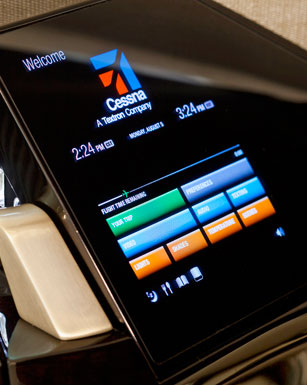
Spec Sheet
Cessna Sovereign
Average equipped price $17.9 million
Specifications
Length | 63 ft 6 in
Height | 20 ft 4 in
Wingspan | 72 ft 4 in
Cabin seats | 9-12
Cabin length | 25 ft 3 in
Cabin width | 66 in
Cabin height | 68 in
Basic operating weight | 18,380 lb
Max ramp weight | 31,025 lb
Max takeoff weight | 30,775 lb
Zero fuel weight | 21,000 lb
Payload w/full fuel | 1,255 lb
Max landing weight | 27,575 lb
Fuel capacity, std | 1,700 gal usable
| 11,390 lb usable
Baggage capacity | 1,415 lb/135 cu ft
Performance
Balanced field length, SL @ 15 deg C/
59 deg F | 3,650 ft
Landing Distance | 2,680 ft
Max operating altitude | 47,000 ft
Range | 3,000 nm
Max cruise speed | 458 KTAS
MMO (max Mach number) | 0.80 M
For more information: www.cessna.com
All specifications are based on manufacturer’s calculations. All performance figures are based on standard day, standard atmosphere, sea level, gross weight conditions unless otherwise noted.


